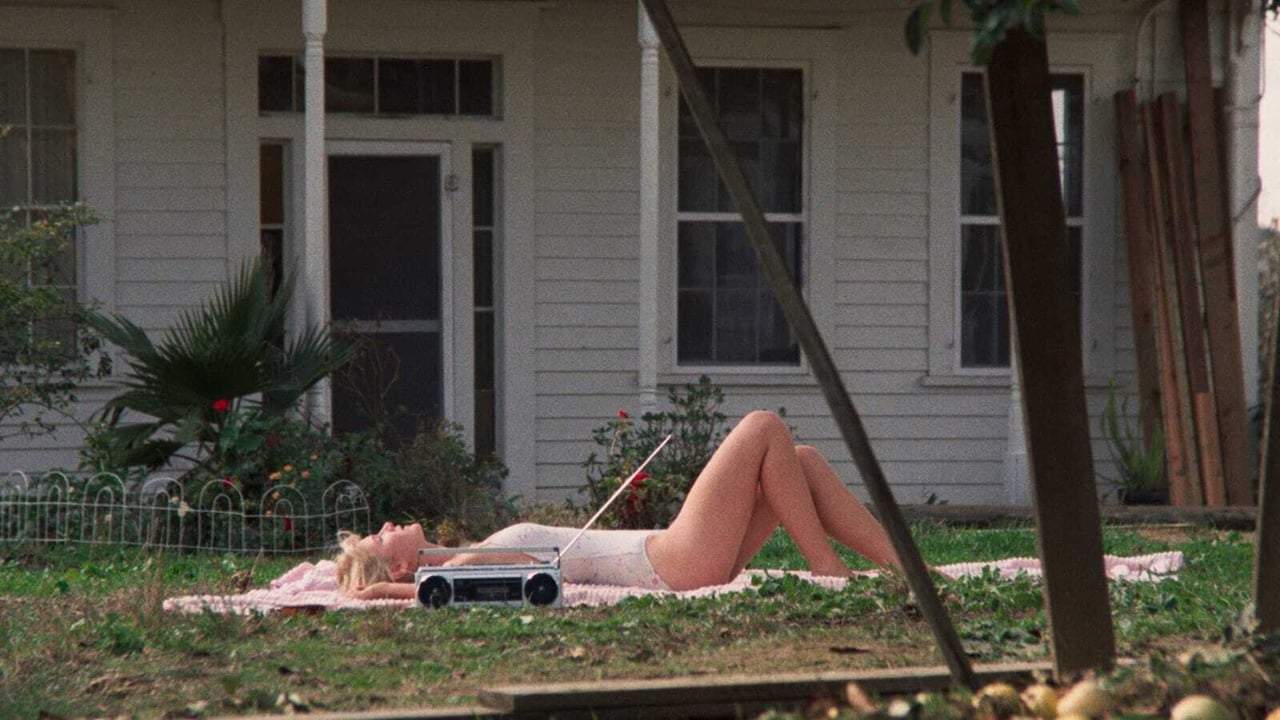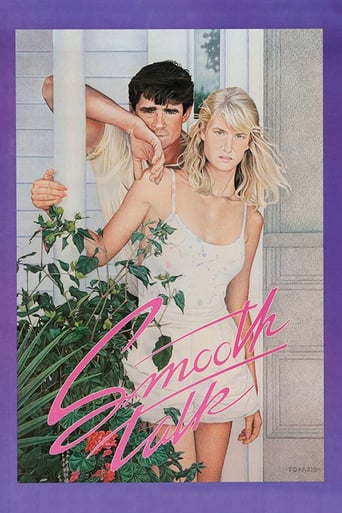



Truly Dreadful Film
Am I Missing Something?
Let me be very fair here, this is not the best movie in my opinion. But, this movie is fun, it has purpose and is very enjoyable to watch.
View MoreThere are moments that feel comical, some horrific, and some downright inspiring but the tonal shifts hardly matter as the end results come to a film that's perfect for this time.
View More"Smooth Talk" is a strange, languid coming-of-age movie that makes a surprising shift into thriller territory toward the end.It's about a young girl, played by Laura Dern, who has a strained relationship with her mother. She lies to her about where she is going so that she can go hang out with her friends. She flirts with boys, and some of these encounters are harmless and fun. Others are threatening.At a party she meets a strange man in passing who tells her he is watching. We don't know how she feels about this, but if the encounter is expected to generate suspense, it doesn't. You might not even notice.Later, the guy (played by Treat Williams) shows up, acting like a refugee from a generic thriller. The scene isn't scary, but the characters talk for so long that you don't know if it's supposed to be. Wouldn't she be scared to the point of ending the conversation?The thriller aspect is handled so negligibly that you are left only with the teen girl angst stuff, which is also just not that interesting or convincing.
View MoreThis was definitely somewhat different to what I had expected. The performances are exquisite, Laura Dern proving she had enormous talent at such a young age. She's fantastic here, infusing her character with the much needed charm and likability it needed, while also proving to be strong-willed and vulnerable in her own way. She certainly had a great year in 1985, with between this and Mask, and it's great to see some of the acting notes she would come to perfect even later on in her career. The supporting cast is nicely balanced and also provides some strong work. The film is contemplative and calm, and the sentiment at the end is very well-earned, such a great final scene to go along with the rest of what the film was actually doing.
View MoreA story of a teen ager edging into maturity. Laura Dern is idiosyncratically beautiful as the 15-year old. She's long legged, deeply tanned, has flowing blond hair that sets off her dark brows and lashes. The problem is that she IS only fifteen. Another year, one way or the other, would be a misjudgment for the writers of this film. Fifteen is just right, half way between ten and twenty, a liminal age.She's uncertain about how to behave. The Generalized Other keeps telling her that she looks as good as she in fact does, but like most adolescents she's absorbed by the issue. She smiles into the mirror and asks, "How do I look?" a dozen times.Her days consist of fibbing to her parents (Levon Helm and Mary Kay Place in one of her best performances) -- portrayed as fairly reasonable folk here. Dern hasn't been at the movies as she claims. Instead she's been hanging around the mall, squealing with delight and disturbing the shops with her two or three girl friends. There are times when, gulp, she hangs at a HAMBURGER JOINT and gossips.She's wary with the several boys who come on to her. "Just not used to being excited," she tells one of them after a bout of necking. At home, things are also at a tipping point. Her sister isn't nearly as glamorous and is jealous, though not bitter. Her Dad is marginal to the family, a nice guy with a vapid smile. Her Mom, Mary Kay Place, is an ordinary mother trying to keep house and trying to enlist Dern's help in household chores such as painting the house and doing the dishes, but Dern is snotty and defiant.About two thirds of the way through I was about to offer my assistance as a family counselor. I know nothing about the subject, but like everyone else I've been through the Sturm und Drang of adolescence while trying to establish an identity outside the family.But then a queer thing happens. A convertible pulls up in front of the family farm house while Laura Dern is alone. She's dressed in a sexy but chaste white outfit. The young man behind the wheel, Treat Williams, looks like a parody of dangerous youth left over from the 1950s. He wears aviator shades, his tight, already short-sleeved shirt has its sleeves rolled up to his triceps, exposing half a tattoo. The shirt is unbuttoned to his sternum. His dungarees are dusty and so are his boots.This is a smooth-talking guy. He is a stranger to her but knows everything about Dern, her family, and her friends. I can't tell whether he's seductive or not. He didn't turn me on. But I can tell that his character is SUPPOSED to be. He's mysterious and a little dangerous. His technique is the same as Charlie Manson's -- I KNOW what you're feeling. He tempts Dern, talks her into taking a drive in his long, shiny, phallic beast. She goes reluctantly. There is a pan of the empty convertible parked in the mountains, leaving the viewer with no more than a suspicion of where the pair are or what they're up to. When they pull back into Dern's driveway, she tells him, with genuine determination, that she doesn't want to see him around here -- ever again. He smiles, says, "Hey, nothing happened", and the mean machine scootches off. Dern walks into the house where she finds her family just returned from the picnic. Now she's polite and forgiving to all of them. In the last scene, Dern dances with her homely sister and they chuckle together.It was during that last scene when I noticed that Dern's bedroom wall was decorated with a rather sizable poster of James Dean. This raises a host of questions, which can be boiled down to just one. Was this episode with the mysterious Treat real or fantasized? Answer: I don't know.Obviously the Treat character serves a symbolic purpose. Her family nudges her towards ordinary respectability, but Treat demonstrates the joys of misbehavior. She faced with a choice. And in the end, she chooses her family and accepts responsibility. It's easy to visualize Dern's future. She grows up to be a stewardess with hopes of marrying an airline pilot.What luscious photography. What apple orchards. What a neat farm house with a sloppily lived-in appearance. It's hard to imagine how the performances could be improved upon, except for Levon Helm who smiles all the time as if playing a "nice guy" for an audience. And, as I say, I couldn't get with Treat Williams as a character and so only barely with his acting. Maybe it's not his problem. How do you play a stereotype convincingly? Overall, though, this is a smooth-flowing movie that doesn't pound its audience over the head with anything. And though it's definitely a portrait of a young woman's life, it's not a teen movie. I don't know that kids of fifteen would not be bored by the sometimes oblique dialog, the lack of action, and the near absence of sex. The film requires the kind of patience that I'm not sure mall rats have any longer. Paradoxically, this is a story about youth that adults might appreciate more than the subjects of the story themselves.I understand that the film is based on a rather darker and more ambiguous story by Joyce Carole Oates who, in turn, was inspired by some Southwestern psychopath, but I can only assess what's been put on the screen.
View MoreThe movie is for the most part was good. I recommend reading the short story which it is based on before you see the movie. The movie sticks to the plot for the most part, but there are a few differences that shouldn't have been added in. The roles of the parents were good and accurately got across the ideas that Connie disliked in them. Laura Dern as Connie did an average job of portraying Connie, the shallow 15 year old. Treat Williams was excellent as the disturbing Arnold Friend. The biggest problem with this film is they gave it a Hollywood "happily ever after" which is completely different from the dark ending of the story. "Where you are going, where have you been" is a very good story and is much darker than "Smooth Talk" but if you are a fan of the story, check this out to compare.
View More